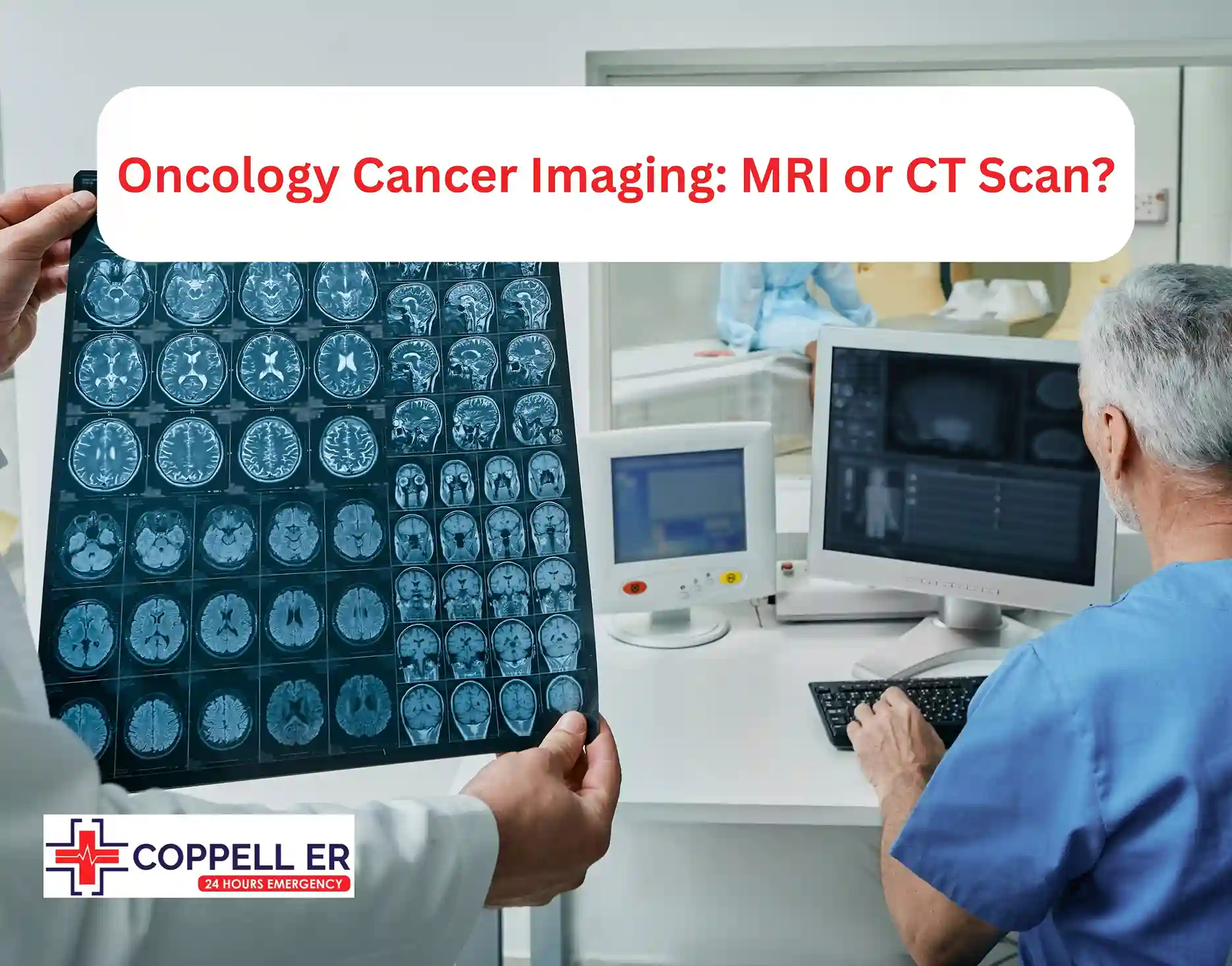When cancer is suspected, choosing the right imaging technique between MRI vs CT scan for cancer detection can impact your diagnosis and treatment. Each cancer imaging tool offers distinct advantages in identifying and monitoring different types of cancer. But which one is truly more effective?
CT scans can rapidly capture detailed images of organs and potential tumor spread. They are highly valued for their speed in initial cancer screening and staging. MRIs, on the other hand, excel at revealing subtle changes in tumors that CT scans might miss.
We’ll explore how these two imaging techniques compare in cancer detection, so you can understand which technology your oncologist might recommend for specific types of cancer and why.
What Is the Difference Between MRI Scan and CT Scan for Cancer Imaging?
MRI and CT scans play an important role in the detection, diagnosis, and monitoring of cancers. A differentiation between the two scans is absolutely essential to understand how each can be used to reveal the specific details needed for cancer imaging.
MRI (Magnetic Resonance Imaging)
MRI is an imaging modality where strong magnetic fields and radio waves are employed in generating highly detailed pictures of soft tissues in the human body. It is specially meant for spine and brain imaging, and other soft tissue structures in the body. This imaging has a renowned capability for distinguishing between different types of tissues; hence, giving it an edge in tumor detection in soft tissues.
CT(Computed Tomography)
CT scans take X-rays and, with the aid of a computer, create cross-sectional images of the body in great detail. A CT scan can visualize not just hard tissues of the body but also soft tissues. Generally, it produces images faster than MRI and thus is often crucial for rapid diagnosis in emergencies. It is highly useful in the chest, abdomen, and pelvis because it emphasizes abnormalities, especially tumors.
MRI vs CT Scan for Cancer: Which Is More Effective?
Choosing between MRI vs CT for cancer involves considering each scan’s specific imaging strengths, as well as patient safety and the need for repeat imaging.
Detail and Tumor Differentiation
The technique of MRI is especially appropriate for imaging soft tissue structures and is therefore often favored when handling cancers of the brain, spinal cord, and other regions where soft tissues are numerous. Its high-contrast resolution enables tumor margins to be more easily delineated, particularly in complex areas.
By comparison, CT scans give a clear view of both soft tissues and bones and are, therefore, commonly used for cancers of the abdomen, chest, and pelvis. CT scans are particularly good at outlining any abnormality within the chest cavity and are therefore particularly useful in cancers such as lung cancer.
Where cancers involve soft tissues, the MRI may have the edge when it comes to detail in the images. For hard tissue cancers or situations where a wider view of the body is required, CT scans tend to be more feasible.
CT vs MRI Radiation Exposure
CT scans involve the use of ionizing radiation, doses of which can accumulate over time and may present some future risk. While the doses are carefully controlled, there is some concern that multiple scans or series of scans will pose some risks, especially for younger patients or those who may be in long-term cancer follow-up.
Conversely, MRI does not use radiation and therefore is safer for repeated imaging. This is a far more important advantage to the patients in continuous need of monitoring, as more frequent scanning can be administered with a much smaller risk from radiation exposure.
In relation to radiation exposure, this lack of ionizing radiation can make MRI preferable among those for whom the protocol calls for multiple follow-up scans when considering CT vs MRI.
Time Efficiency
Generally, CT Scans are faster than MRIs, often taking just a few minutes. Such speed is particularly priceless in emergency settings or where the need for rapid diagnosis is felt, as in acute care trauma or metastasis-related cancer diagnoses.
MRI Scans take even longer and can be up to an hour; this could be quite challenging for patients who might feel uncomfortable and must stay still for extended periods.
CT may be better reserved for patients with conditions that require immediate imaging studies. In cases where subtle changes in cancers are to be followed, the extra time spent on MRI may be well utilized.
Oncology Imaging by Cancer Type: MRI or CT Scan?

Brain and Spinal Cord Tumors
Preferred Modality: MRI – The ability of MRI to give the fine details of the brain and spinal cord makes it stand out for the imaging of these cancers. MRI’s high soft tissue contrast enables the correct identification and evaluation of tumor boundaries, with potential infiltration into surrounding tissues.
Lung Cancer
Preferred Modality: CT Scan – The use of CT scan versus MRI in the diagnosis of cancer is heavily inclined to the former in the case of lung cancer, as it produces sharp images of the lungs and chest cavity. It is also a helpful modality for the establishment of lymph node involvement and staging of the cancer, which is crucial to the planning of treatment for lung cancer.
Abdominal and Pelvic Cancers
Combination of MRI and CT: MRI and CT imaging together have been used in cancers originating in the abdomen or pelvis, such as liver, kidney, and ovarian cancers. While the CT scan provides a broad overview, MRI can allow the added advantage of detailing soft tissue structures, thus providing a fuller picture of the location and characteristics of a tumor.
Bone Cancer
Preferred Modality: CT Scan – CT is excellent for structural bony details and their involvement in bone malignancies. MRI, however, can be utilized to further delineate soft tissue involvement that might occur along with bone detail provided by the CT.
Why MRI Scans Are Important in Cancer Treatment

MRI scans are important in cancer imaging, particularly in soft tissues of the body. If one has symptoms such as abnormal bleeding, unexplained weight loss, or changes in body functions, an MRI gives helpful information to confirm or eliminate cancer. MRI will be able to detect tumors that are latent and not visible outwardly.
They can determine the nature of a tumor-whether malignant or otherwise-by observing the characteristics of the tissue. They can measure the size of a tumor and assess its spread. They can also evaluate blood flow around the tumor and monitor treatment results, such as those from chemotherapy. Additionally, MRI scans are used for follow-up imaging to check for recurrence.
Why CT Scans Are Necessary for Cancer Detection
Computed tomography is an important cancer imaging tool, especially when attempting to look at very dense tissues or in instances where speed of imaging may be critical. Symptoms such as chronic coughing, unexplained chest pain, and changes in bowel habits call for a CT scan in cases involving tumors in the solid regions of the lungs or bones, metastasis by cancerous cells, and determining the extent of cancer progression.
CT scans also help in guiding biopsies and assessing the treatment effects. Enhanced with contrast dye, CT images delineate tumor boundaries and help differentiate cancerous from healthy tissues, making CT a dependable option in a wide range of cancers.
Key Takeaway
Selecting between MRI and CT scans for cancer imaging and monitoring depends on factors like the type and location of the cancer, the patient’s health condition, and the frequency of imaging required.
MRI is particularly useful for soft tissue cancers, while CT scans are favored for broader overviews and faster imaging results. For many patients, using both MRI and CT scans in oncology imaging provides the most effective approach.
For those seeking expert advice on the best imaging options for their specific condition, consulting healthcare facilities equipped for emergency cancer imaging can ensure timely and accurate cancer care.
Schedule Your Imaging Consultation Today
FAQs
Which is the best scan to detect cancer?
The best scan for detecting cancer depends on the type and location. CT scans are great for general imaging, while MRIs are ideal for soft tissues like the brain and spinal cord.
Can a tumor show up in an MRI but not CT?
A tumor may show up on an MRI but not on a CT scan because MRIs are particularly effective at imaging soft tissues, capturing finer details in certain types of tumors that CT scans may miss, especially those in the brain and spinal cord.
Can an MRI tell if a mass is cancerous?
An MRI can help determine whether a mass is malignant or benign by providing detailed images of soft tissues. However, despite the high sensitivity of MRI studies for tumor detection, a cancer diagnosis cannot always be made solely based on MRI results.
Typically, confirmatory tests, such as a biopsy, are needed to confirm whether the tumor is malignant or benign.




